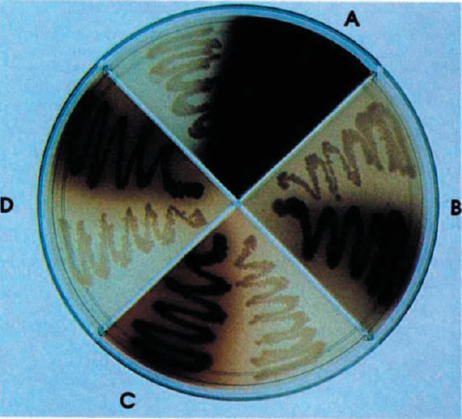Virginia/Projects/2
From 2007.igem.org
Amy Schell (Talk | contribs) (→Motivation and References) |
Amy Schell (Talk | contribs) (→'''Bacterial Melanogenesis''') |
||
| Line 2: | Line 2: | ||
<center>[https://2007.igem.org/Virginia http://www.parking-net.com/Upload/Jobs/6162/university-of-va-web-logo.jpg]</center> | <center>[https://2007.igem.org/Virginia http://www.parking-net.com/Upload/Jobs/6162/university-of-va-web-logo.jpg]</center> | ||
=='''Bacterial Melanogenesis'''== | =='''Bacterial Melanogenesis'''== | ||
| + | [[Image:melanin.jpg]] | ||
We have designed a light-inducible system in ''E. coli'' capable of manufacturing and secreting melanin. This biological machine is built from two standard biological parts, a melanin generator and a red light-inducible plasmid. | We have designed a light-inducible system in ''E. coli'' capable of manufacturing and secreting melanin. This biological machine is built from two standard biological parts, a melanin generator and a red light-inducible plasmid. | ||
===Motivation=== | ===Motivation=== | ||
Revision as of 15:21, 19 July 2007
Bacterial Melanogenesis
 We have designed a light-inducible system in E. coli capable of manufacturing and secreting melanin. This biological machine is built from two standard biological parts, a melanin generator and a red light-inducible plasmid.
We have designed a light-inducible system in E. coli capable of manufacturing and secreting melanin. This biological machine is built from two standard biological parts, a melanin generator and a red light-inducible plasmid.
Motivation
According to the American Cancer Society, skin cancer is the most common form of all cancers. It accounts for nearly half of all cancers in the United States. Due to its natural defense mechanism, skin must first be exposed to UV radiation before melanogenesis begins. Thus, we thought it would be convienient to be able to produce melanin in response to another harmless wavelength. This technology may, in the future, lead to treatments for albinism and a safe alternative for cosmetic tanning. Additionally, melanin may be used as a natural indicator in the laboratory as well as an acoustic material. According to a study by Kono, et. al., melanin is capable of absorbing ultrasound.
Background
In humans, melanin is found in the skin, hair, iris, adrenal gland, inner ear, and various pigment-producing regions of the brain.
Melanin is the primary determinant of skin color. The process of tanning originates in specialized cells called melanocytes. When stimulated by ultraviolet radiation, these cells produce melanin, which then migrates to the neighboring keratinocytes. The melanin accumulates above the receiving cells' nuclei in order to protect genetic material from from mutations caused by the sun's ionizing radiation.
Though there are many types of melanin, they are all polymers which contain derivatives of the amino acid tyrosine. Melanin is an aggregate of smaller component molecules; the various types of melanin have differing proportions and bonding patterns of the component molecules. Three types of melanin found in humans include eumelanin, pheomelanin, and neuromelanin. Eumelanin, which produces a brown-black color, is most common.
References:
Wu, Corrina. Unraveling the Mystery of Melanin. Sept 18, 1999. Vol 156, No 12.
[http://www.mbceo.com/science/more_information.php?c=Melanin Information and Facts About Melanin]
Biobrick design
Include plasmid diagrams.
Methods and Materials
methods of measurement
Results and Conclusions
TBD